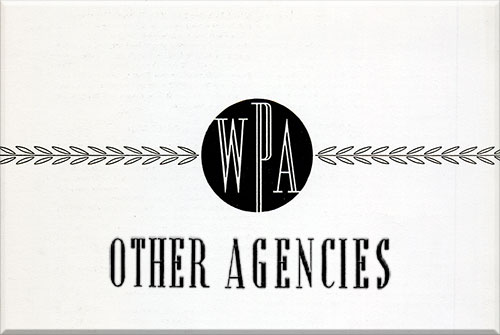Other Agencies During the Great Depression Era - 1938

Other Agencies. Inventory: An Appraisal of Results of the Works Progress Administration, Washington, DC: US Government Printing Office, 1938. GGA Image ID # 1530f107d4
While operations of the WPA have accounted for over half of the funds used in conducting the Works Program (including both Federal and sponsors' funds for projects drawing upon ERA Act money as well as the PWA non-Federal project money and the CCC appropriations after the fiscal year ending in June 1936) and for about three-quarters of total Works Program employment, more than forty other Federal agencies also have conducted extensive operations of widely varied types.
The Works Program funds of these agencies aggregate more than four billion dollars. More than four-fifths of value of the projects of agencies other than the WPA has been for conservation, public buildings—including housing, public roads, sewer, water, and other utilities.
Much of this construction work has been of the heavier type, performed by private contract, and none of it is, of course, reflected in the previous pages of this report. A few brief highlights of the major Works Program activities of the other Federal agencies are listed here to show the general nature of the work.
Conservation
About 40 percent of the outlay by other Federal agencies has been devoted to conservation of natural resources. This includes the work of the Civilian Conservation Corps, which in the first 2 years of Works Program activities built over 2,000,000 erosion check dams, planted or moved 15,000,000 trees or shrubs, built 45,000 miles of roads and trails, and 8,000 bridges, as well as many other related facilities in parks and National forests.
It also includes work on more than a score of major irrigation developments by the Bureau of Reclamation, such as the Grand Coulee Dam and the Casper-Alcova irrigation project.
Conservation, in the broad sense, likewise embraces the flood-control program of the corps of engineers and the channel dredging and waterpower developments of PWA non-Federal projects, as well as the general work of the Forest Service, which has built over 4,000 miles of fence, collected 1,200,000 pounds of tree seed and constructed many facilities to check forest fires.
In the same category is much work by the Soil Conservation Service, which has protected over 1,500,000 acres against erosion by 74,000 miles of terracing, planted 250,000,000 trees, strip-cropped almost 1,000,000 acres of land, built over 2,500,000 gully-controlling structures, and 20,000 storage ponds for the watering of livestock.
The Farm Security Administration has protected land resources by promoting proper land use and has aided more than 400,000 families through rehabilitation loans and another 400,000 through rehabilitation grants.
The Bureau of Entomology and Plant Quarantine has surveyed over 100,000,000 acres and waged a widespread fight against the Dutch Elm disease and many other tree or plant maladies.
Public Buildings
Nearly one-fourth of the program of other Federal agencies has been devoted to construction of public buildings, the major portion of which is represented by some 4,000 schoolhouses, city halls, courthouses, and other major public structures built as non-Federal projects of the Public Works Administration.
This field also includes two major low-cost housing programs—the urban housing projects of the PWA Housing Division such as Williamsburg Houses in New York City, and the rural or suburban developments of the Farm Security Administration such as the "Green- belt Towns."
It also embraces work on many Federally owned buildings, including numerous military and naval facilities.
Roads and Streets
The highway and street program of the other Federal agencies represents an outlay about two-thirds as large as that for public buildings, and here the dominant agency has been the Bureau of Public Roads, which has built 23,000 miles of highways.
The bulk of this is high-type construction on primary routes. The Bureau also has eliminated over 1,600 dangerous grade crossings. The rest of this program is composed largely of PWA non-Federal road projects, chiefly on major highways entering cities or towns.
The only other major type of activity is the PWA's 1,500 projects to construct water and sewer systems, incinerators, and municipal gas or electric plants. Kindred work was done by the Rural Electrification Administration, the War and Navy Departments, and the Coast Guard.
Many Federal agencies have carried out major research projects, such as the Nationwide health inventory of the Public Health Service.
U. S. GOVERNMENT PRINTING OFFICE 16—7624

